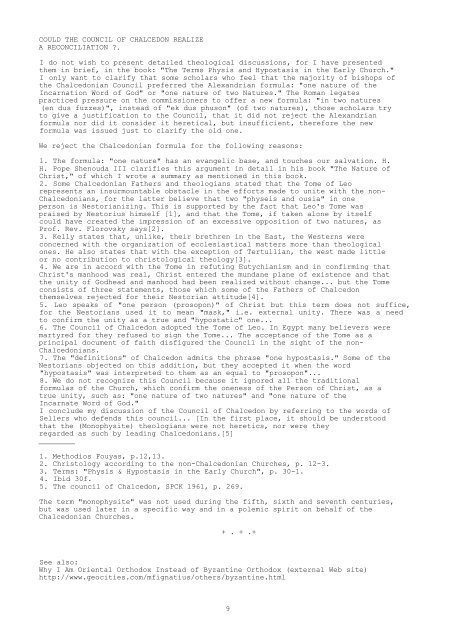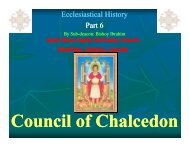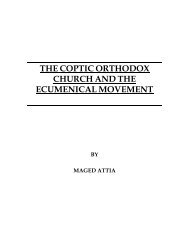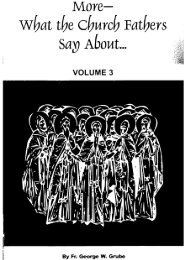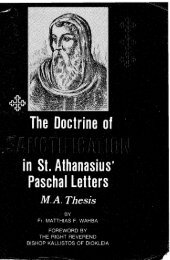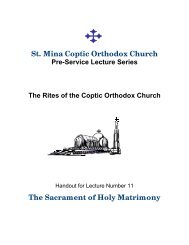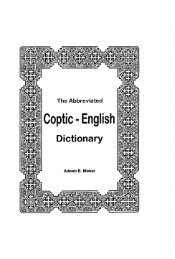Coptic interpretations of the Fourth Ecumenical Council - Saint Mina ...
Coptic interpretations of the Fourth Ecumenical Council - Saint Mina ...
Coptic interpretations of the Fourth Ecumenical Council - Saint Mina ...
You also want an ePaper? Increase the reach of your titles
YUMPU automatically turns print PDFs into web optimized ePapers that Google loves.
COULD THE COUNCIL OF CHALCEDON REALIZE<br />
A RECONCILIATION ?<br />
I do not wish to present detailed <strong>the</strong>ological discussions, for I have presented<br />
<strong>the</strong>m in brief, in <strong>the</strong> book: "The Terms Physis and Hypostasis in <strong>the</strong> Early Church."<br />
I only want to clarify that some scholars who feel that <strong>the</strong> majority <strong>of</strong> bishops <strong>of</strong><br />
<strong>the</strong> Chalcedonian <strong>Council</strong> preferred <strong>the</strong> Alexandrian formula: "one nature <strong>of</strong> <strong>the</strong><br />
Incarnation Word <strong>of</strong> God" or "one nature <strong>of</strong> two Natures." The Roman legates<br />
practiced pressure on <strong>the</strong> commissioners to <strong>of</strong>fer a new formula: "in two natures<br />
(en dus fuzzes)", instead <strong>of</strong> "ek dus phuson" (<strong>of</strong> two natures), those scholars try<br />
to give a justification to <strong>the</strong> <strong>Council</strong>, that it did not reject <strong>the</strong> Alexandrian<br />
formula nor did it consider it heretical, but insufficient, <strong>the</strong>refore <strong>the</strong> new<br />
formula was issued just to clarify <strong>the</strong> old one.<br />
We reject <strong>the</strong> Chalcedonian formula for <strong>the</strong> following reasons:<br />
1. The formula: "one nature" has an evangelic base, and touches our salvation. H.<br />
H. Pope Shenouda III clarifies this argument in detail in his book "The Nature <strong>of</strong><br />
Christ," <strong>of</strong> which I wrote a summary as mentioned in this book.<br />
2. Some Chalcedonian Fa<strong>the</strong>rs and <strong>the</strong>ologians stated that <strong>the</strong> Tome <strong>of</strong> Leo<br />
represents an insurmountable obstacle in <strong>the</strong> efforts made to unite with <strong>the</strong> non-<br />
Chalcedonians, for <strong>the</strong> latter believe that two "physeis and ousia" in one<br />
person is Nestorianizing. This is supported by <strong>the</strong> fact that Leo's Tome was<br />
praised by Nestorius himself [1], and that <strong>the</strong> Tome, if taken alone by itself<br />
could have created <strong>the</strong> impression <strong>of</strong> an excessive opposition <strong>of</strong> two natures, as<br />
Pr<strong>of</strong>. Rev. Florovsky says[2].<br />
3. Kelly states that, unlike, <strong>the</strong>ir brethren in <strong>the</strong> East, <strong>the</strong> Westerns were<br />
concerned with <strong>the</strong> organization <strong>of</strong> ecclesiastical matters more than <strong>the</strong>ological<br />
ones. He also states that with <strong>the</strong> exception <strong>of</strong> Tertullian, <strong>the</strong> west made little<br />
or no contribution to christological <strong>the</strong>ology[3].<br />
4. We are in accord with <strong>the</strong> Tome in refuting Eutychianism and in confirming that<br />
Christ's manhood was real, Christ entered <strong>the</strong> mundane plane <strong>of</strong> existence and that<br />
<strong>the</strong> unity <strong>of</strong> Godhead and manhood had been realized without change... but <strong>the</strong> Tome<br />
consists <strong>of</strong> three statements, those which some <strong>of</strong> <strong>the</strong> Fa<strong>the</strong>rs <strong>of</strong> Chalcedon<br />
<strong>the</strong>mselves rejected for <strong>the</strong>ir Nestorian attitude[4].<br />
5. Leo speaks <strong>of</strong> "one person (prosopon)" <strong>of</strong> Christ but this term does not suffice,<br />
for <strong>the</strong> Nestorians used it to mean "mask," i.e. external unity. There was a need<br />
to confirm <strong>the</strong> unity as a true and "hypostatic" one...<br />
6. The <strong>Council</strong> <strong>of</strong> Chalcedon adopted <strong>the</strong> Tome <strong>of</strong> Leo. In Egypt many believers were<br />
martyred for <strong>the</strong>y refused to sign <strong>the</strong> Tome... The acceptance <strong>of</strong> <strong>the</strong> Tome as a<br />
principal document <strong>of</strong> faith disfigured <strong>the</strong> <strong>Council</strong> in <strong>the</strong> sight <strong>of</strong> <strong>the</strong> non-<br />
Chalcedonians.<br />
7. The "definitions" <strong>of</strong> Chalcedon admits <strong>the</strong> phrase "one hypostasis." Some <strong>of</strong> <strong>the</strong><br />
Nestorians objected on this addition, but <strong>the</strong>y accepted it when <strong>the</strong> word<br />
"hypostasis" was interpreted to <strong>the</strong>m as an equal to "prosopon"...<br />
8. We do not recognize this <strong>Council</strong> because it ignored all <strong>the</strong> traditional<br />
formulas <strong>of</strong> <strong>the</strong> Church, which confirm <strong>the</strong> oneness <strong>of</strong> <strong>the</strong> Person <strong>of</strong> Christ, as a<br />
true unity, such as: "one nature <strong>of</strong> two natures" and "one nature <strong>of</strong> <strong>the</strong><br />
Incarnate Word <strong>of</strong> God."<br />
I conclude my discussion <strong>of</strong> <strong>the</strong> <strong>Council</strong> <strong>of</strong> Chalcedon by referring to <strong>the</strong> words <strong>of</strong><br />
Sellers who defends this council... [In <strong>the</strong> first place, it should be understood<br />
that <strong>the</strong> (Monophysite) <strong>the</strong>ologians were not heretics, nor were <strong>the</strong>y<br />
regarded as such by leading Chalcedonians.[5]<br />
1. Methodios Fouyas, p.12,13.<br />
2. Christology according to <strong>the</strong> non-Chalcedonian Churches, p. 12-3.<br />
3. Terms: "Physis & Hypostasis in <strong>the</strong> Early Church", p. 30-1.<br />
4. Ibid 30f.<br />
5. The council <strong>of</strong> Chalcedon, SPCK 1961, p. 269.<br />
The term "monophysite" was not used during <strong>the</strong> fifth, sixth and seventh centuries,<br />
but was used later in a specific way and in a polemic spirit on behalf <strong>of</strong> <strong>the</strong><br />
Chalcedonian Churches.<br />
+ . + .+<br />
See also:<br />
Why I Am Oriental Orthodox Instead <strong>of</strong> Byzantine Orthodox (external Web site)<br />
http://www.geocities.com/mfignatius/o<strong>the</strong>rs/byzantine.html<br />
9


